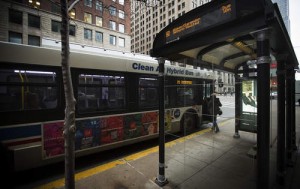By Rosalind Rossi

Wondering when the next CTA bus will arrive?
More than 100 more fancy JCDecaux bus shelters will carry that up-to-the-minute information by August, via new bus tracker arrival-time signs trumpeted along their sides.
Chicago Transit Authority officials Friday agreed to pay JCDecaux up to $2.2 million over up to four years to expand its installation and maintenance of such signs from the current 150 to 258.
That means that eight months from now, each ward should have at least two glass-enclosed bus shelters with LED signs displaying bus arrival information, said Eric Reese, CTA director of revenue.
“People love them. You can see the actual arrival time of the bus,’’ Reese said Friday. “I check bus tracker [on a smart phone] before leaving my house and as I approach my stop, I see a more updated time of when it’s coming.’’
The 258 information-rich shelters represent only a fraction of the 11,000 bus stops in the system, but bus tracker signs can’t be posted at every stop, CTA officials cautioned. They currently are only being installed above the glass exterior of JCDecaux bus shelters that have access to electric feeds, CTA officials said.
Other new fancy CTA signs in the offing include 52-inch electronic billboards that should be installed in 50 CTA stations or subway stations by this summer, Reese said. A company called Titan will be placing both ads and bus tracker info on the new “digital urban panels,’’ Reese said. About 25 stations currently have smaller versions of the same signs, he said.
Also Friday, CTA board members agreed to pay up to $148 million for a minimum 300 new clean diesel buses that should hit the streets by February 2014. The 37-seat buses will feature lower entrance steps, multiple security cameras and improved fuel economy, officials said.
In other news, pleas that the CTA consider allowing reduced-fares for homeless youth caught a receptive ear from CTA board members.
Jesse Moore, 21, said he wound up homeless after a violent crime left him near death and in an intensive care unit. He never had enough money to pay for a 30-day CTA pass to get him to medical appointments and potential job sites. Now that he’s found a job, Moore told board members, he’s not eligible for a reduced fare u-pass or student pass because he’s not in school.
Moore was supported by Jeri Lynch Linas, executive director of Teen Living Programs, who said her biggest line item, outside food, is the $35,000 a year her agency spends on transportation for needy youth. “There’s a huge need for transportation on a daily basis,’’ Linas told board members. If their fares were lower, she could help more of them, she said.
However, CTA President Forrest Claypool cautioned that the law only allows the CTA to provide discounted fares to certain categories of riders. Currently, he said, reduced fares are tied to students, who will see a further reduction in their fares starting Monday.
CTA Board Chair Terry Peterson said he wanted to “try to work through this’’ and find a way to help “these kids caught in the middle.’’ Said Peterson: “There has to be a creative way to address this.’’
Claypool also told reporters Friday he was “confident’’ signage errors on the new No. 37 bus route, which started Dec. 16, finally had been corrected. Demands by some DePaul area businesses that bus tow zones along the new weekday-only route be limited to Monday through Friday should be discussed with the Chicago Department of Transportation, CTA officials said.
However, Claypool cautioned that if bus tow zone signs allow weekend-only parking, as is common in the Old Town leg of the No. 37, “you end up with cars there during the Monday morning rush hour. Just because there’s a sign does not mean it’s followed.’’
